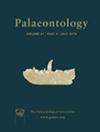Gradual warming prior to the end‐Permian mass extinction
IF 2.3
2区 地球科学
Q1 PALEONTOLOGY
引用次数: 4
Abstract
The biggest known mass extinction in the history of animal life occurred at the Permian–Triassic boundary and has often been linked to global warming. Previous studies have suggested that a geologically rapid (<40 kyr) temperature increase of more than 10°C occurred simultaneously with the main extinction pulse. This hypothesis is challenged by geochemical and palaeontological data indicating profound environmental perturbations and a temperature rise prior to the main extinction. Using secondary ion mass spectrometry (SIMS), we measured oxygen isotope ratios from Changhsingian (late Permian) ostracods of north‐western Iran. Our data show that ambient seawater temperature began to rise at least 300 kyr prior to the main extinction event. Gradual warming by approximately 12°C was probably responsible for initial environmental degradation that eventually culminated in the global end‐Permian mass extinction.二叠纪末大灭绝前的逐渐变暖
动物生命史上已知的最大规模灭绝发生在二叠纪-三叠纪边界,通常与全球变暖有关。先前的研究表明,地质快速(<40 kyr)温度升高超过10°C与主消光脉冲同时发生。地球化学和古生物学数据对这一假设提出了质疑,这些数据表明,在大灭绝之前,环境受到了深刻的扰动,温度上升。使用二次离子质谱法(SIMS),我们测量了伊朗西北部长兴店(晚二叠世)介形虫的氧同位素比率。我们的数据显示,环境海水温度开始上升至少300 主要灭绝事件之前的kyr。大约12°C的逐渐变暖可能是最初环境退化的原因,最终导致全球二叠纪末大灭绝。
本文章由计算机程序翻译,如有差异,请以英文原文为准。
求助全文
约1分钟内获得全文
求助全文
来源期刊

Palaeontology
地学-古生物学
CiteScore
5.60
自引率
3.80%
发文量
43
审稿时长
6 months
期刊介绍:
Palaeontology publishes a wide variety of papers on palaeontological topics covering:
palaeozoology
palaeobotany
systematic studies
palaeoecology
micropalaeontology
palaeobiogeography
functional morphology
stratigraphy
taxonomy
taphonomy
palaeoenvironmental reconstruction
palaeoclimate analysis and biomineralization studies.
 求助内容:
求助内容: 应助结果提醒方式:
应助结果提醒方式:


